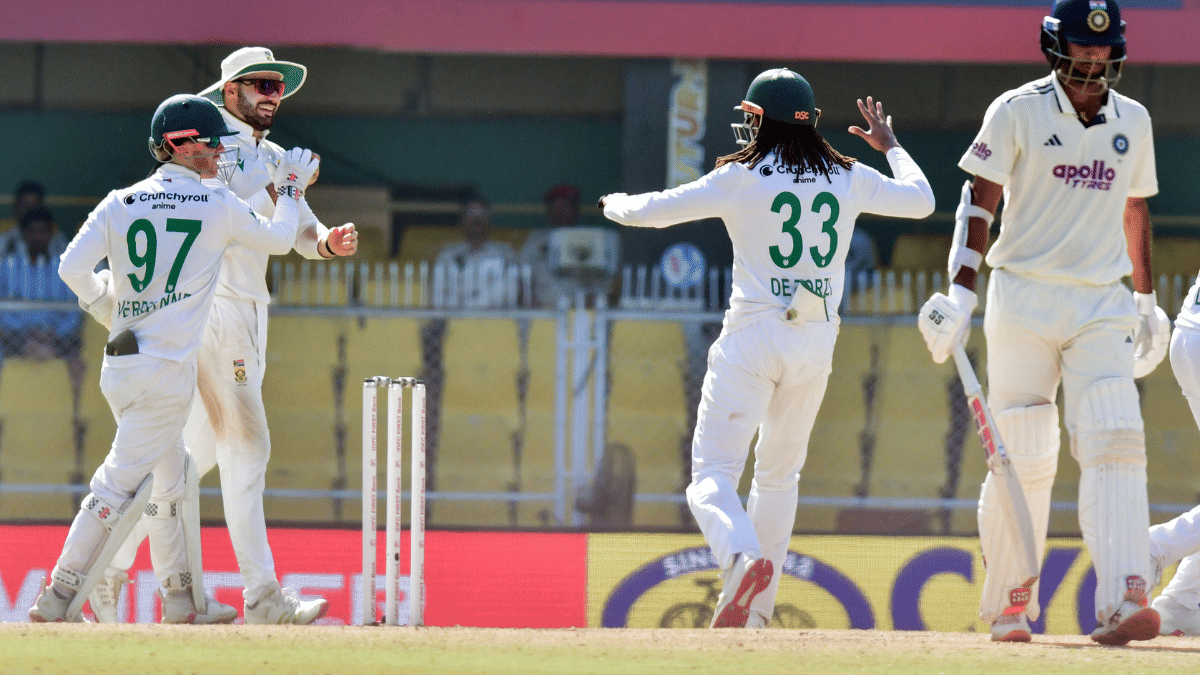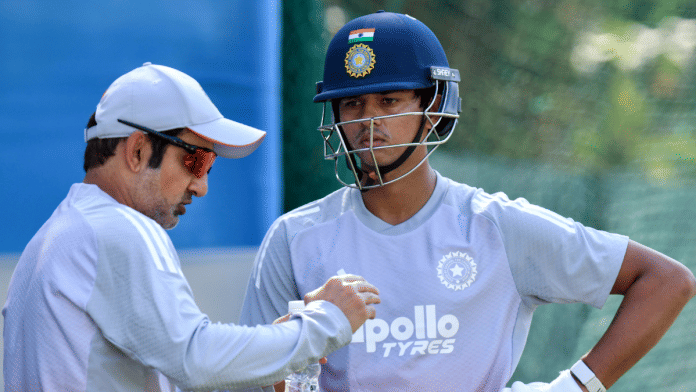New Delhi: While fans and other stakeholders dissected India’s horrible show against the Proteas, a statement made by the touring side’s head coach Shukri Conrad created quite a stir.
“We wanted India to spend as much time on their feet out in the field. We wanted them to really grovel, to steal a phrase, bat them completely out of the game and then say to them, ‘well, come and survive on the last day and an hour this evening,” Conrad told a press conference after the end of the fourth day’s play in Guwahati.
The phrase “grovel” has a racial undertone in historical context. On the cricket field, it was last used in 1976 by then England captain Tony Greig against the West Indian side.
However, it was another statement made by Conrad at the same presser that was equally telling, if not damning, for the Indian team that was staring at its second clean-sweep defeat in the three series at home since last year.
“I think we might be just a bit better equipped in these conditions,” Conrad drove the dagger through the hearts and minds of Indian fans who are not accustomed to being tormented, both on and off the field, by a visiting side in the longest format of the game.
For 12 years, no team could defeat India at home in a Test series. The 2012 defeat had also come as an unlikely loss against an England side that did not ooze confidence against spinning balls. Then came the crushing 3-0 defeat in 2024 at the hands of an unassuming New Zealand side led by Tom Latham.
Reeling from that humiliating defeat, then captain Rohit Sharma had remarked that the Indian team was “allowed” one series loss in “12 years”. Sharma has since moved on. The great Virat Kohli has retired.
But Gautam Gambhir remains at the helm as head coach—and he does not have the “12-year” legacy to cushion a second successive Test series defeat at home. The 408-run mauling by the Proteas in the second Test stands as India’s worst loss by runs in their history. After all, he was appointed as head coach of the Indian side with much fanfare.
𝗣𝗮𝘀𝘀𝗶𝗻𝗴 𝗼𝗻 𝘁𝗵𝗲 𝗯𝗮𝘁𝗼𝗻 𝘄𝗶𝘁𝗵 𝗰𝗹𝗮𝘀𝘀 & 𝗴𝗿𝗮𝗰𝗲! 📝
To,
Gautam Gambhir ✉
From,
Rahul Dravid 🔊#TeamIndia | #SLvIND | @GautamGambhir pic.twitter.com/k33X5GKHm0
— BCCI (@BCCI) July 27, 2024
With questions being asked about his job, Gambhir told the post-match press conference Wednesday, “It is for the BCCI to decide (my future). I have said this before as well, Indian cricket is important, I am not important.”
And then he added, “I am the same guy who got results in England, won the Champions Trophy, and the Asia Cup. This is a team which is learning.”
Also Read: Bumrah is India’s most used bowler. Stats show team’s bowling brain is also its workhorse
Chaos and confusion
But what can players learn if they are not allowed to settle in a position. Take, for example, Washington Sundar’s batting positions in his last five Tests in England and India—eight, five, eight, nine, seven, three, three, eight, eight.
While a jump on either side from number eight to nine or five is fathomable, a number three batting position against the Proteas at the Eden Gardens in the first Test was the most significant leap of faith by the Gautam Gambhir-led think tank.
With that decision, Sundar was elevated to the role of the fountainhead of a batting group, at the expense of another young man, Sai Sudarshan, who is also not sure of his place and batting position.
Sundar did his reputation no harm, batting with exemplary solidity on the spinning Kolkata track. His team, however, suffered a heavy defeat. South Africa went 1-0 up.
What really struck fans in the first Test was that Sundar bowled just one over across the two innings. Based on the number he was sent out to bat, and the number of overs he was trusted to bowl, the team management presumably played him as a frontline batter.

Cut to the second Test, Gambhir-led think tank went back to Sudarshan at number three, and Sundar at eight, despite the top order failing once again. As a bowler, in quite a contrast from Kolkata, Sundar was the first spinner stand-in skipper Rishabh Pant brought into the attack on Day 1 in Guwahati.
What does this suggest? Either Sudarshan was not good enough to bat at number three in Kolkata—in which case he should not have returned to the playing XI in the second Test—or Sundar was not good enough a bowler—in which case he should not have been playing in a three-man spin attack in Guwahati.
The musical chairs and uncertainty around one of the most critical batting positions in a two-game series defied logic. It suggested nothing but a lack of clarity among the men who matter in the dressing room.
There should not be any doubt on who is calling the shots in the team selection and the composition of the playing XI, considering Shubman Gill is new to the role and learning on the job, and Pant was just standing in for Gill.
The series against the Proteas was not the first time Gambhir’s unpredictability has hurt the team. It was evident during the tour of England as well, with Sudarshan again at the centre of it.
After trusting him to bat at number three against England in the first Test, the Gambhir-led management discarded him from the playing XI in the second Test. Out came Karun Nair, straight from the number six position to number three. He showed promise but could not capitalise on good starts to make a big score and solidify his position. Three games later, Sudarshan was back in, and at number three position.
None of these batters scored heavy runs to justify selection, but constant chopping and changing of personnel at key positions, such as number three, has really come back to haunt India.
Jim Collins, an American researcher and writer with a proven pedigree as an author of books on industries and companies, has said in his book ‘Good to Great’ that companies that attain great heights over time identify their ‘who’ rather than deciding on their ‘what.’ Collins asserted that when companies find out who the best individuals are for them, eventually, those individuals will choose the best plan of action and its execution to produce desirable results.
When the team began a transition, Gambhir needed to draft a template and identify who would be entrusted with key roles. The personnel selected to do the job from the outset should have been trusted with conviction and given a longer rope, either to ensure they are not fit for the role or to give them time to iron out their flaws and earn confidence with each opportunity.
Fundamental flaws in approach
Dhruv Jurel grabbed his opportunities with both hands against the West Indies, and India decided to continue with him as a specialist batter, with Pant returning to the side against South Africa.
This meant that Nitish Kumar Reddy did not find a place in the playing XI in the first Test against the Proteas. The Board of Control for Cricket in India (BCCI) released him to play 50-over games for India against South Africa A in Rajkot.
However, after India suffered a heavy defeat in Kolkata while playing as many as four spinners, including Axar Patel, Reddy was called in for the second Test.
Reddy has been backed by Gambhir since the Australia tour last year. He takes the place of a specialist quick bowler, burdening the duo of Jasprit Bumrah and Mohammed Siraj.
When Reddy was first drafted in, it was presumed he was being groomed as an all-rounder. However, Shubman Gill never trusted him with the ball beyond four overs across two Tests against West Indies.

Against SA, Reddy was made to fly from India’s west in Gujarat to the east in Guwahati, only to be given six of the 151 overs India bowled to SA.
During the Australia tour too last year, India did not bowl him regularly either due to fitness issues or a lack of control over line and length, leaving the team with only three wicket-taking options.
If Reddy’s bowling is so far off to be not given even 10 overs when India are bowling 150, what did he play in the side for? As a batter? His returns against South Africa—10 and 0.
It could have served India well if any specialist batter, in Devdutt Paddikal or Sarfaraz Khan, had played instead of him. Not that other batters succeeded, which highlights his ineffectiveness with the bat, but surely he is not among India’s best batters in the longest format.
The obsession of the Gambhir-led think tank with bit-and-piece players such as Reddy is creating nothing but an illusion of depth in both batting and bowling. However, in real terms, these players, at their current skill level, do not add much to either department.
There should be room for sides to groom players into becoming what the team management believes they could become in future. But in that case, the players should be trusted with that responsibility, and Reddy has not been given enough opportunity with the ball either.
(Edited by Ajeet Tiwari)
Also Read: Sunil Gavaskar on disadvantages of cricketers taking frequent breaks. ‘Very difficult to win after’






